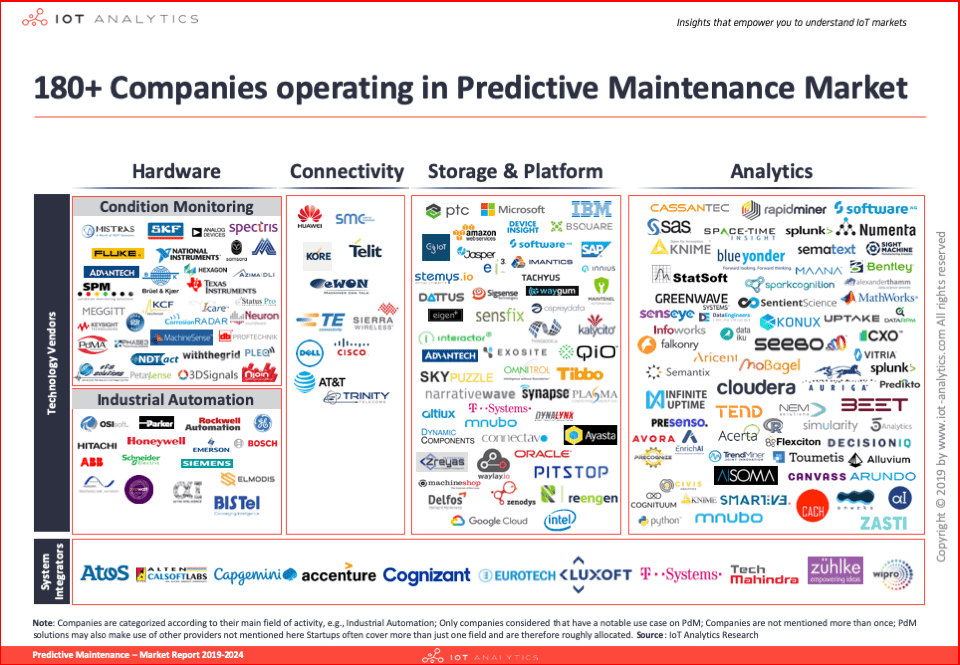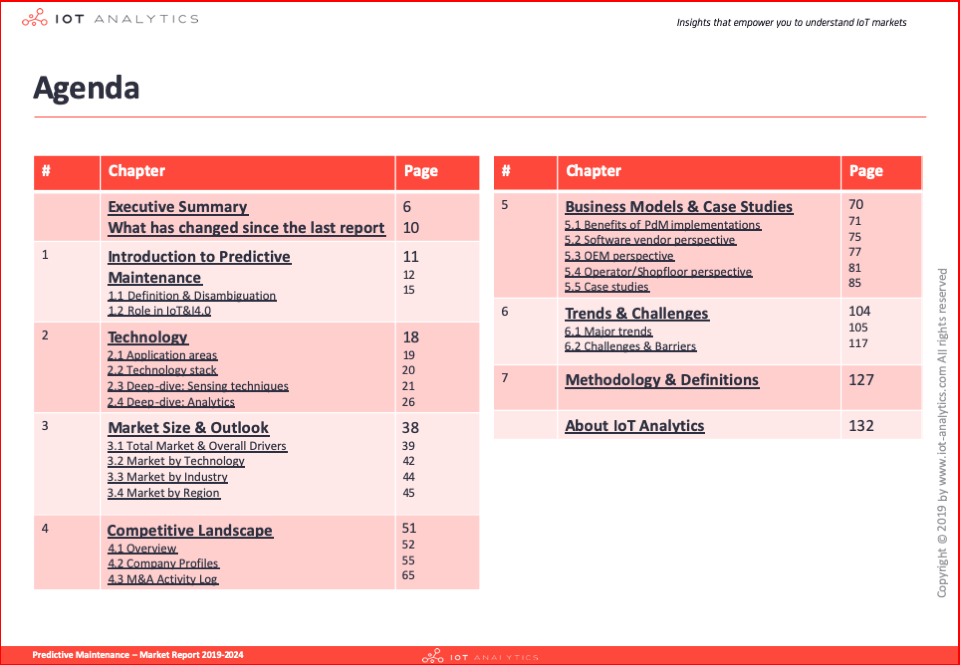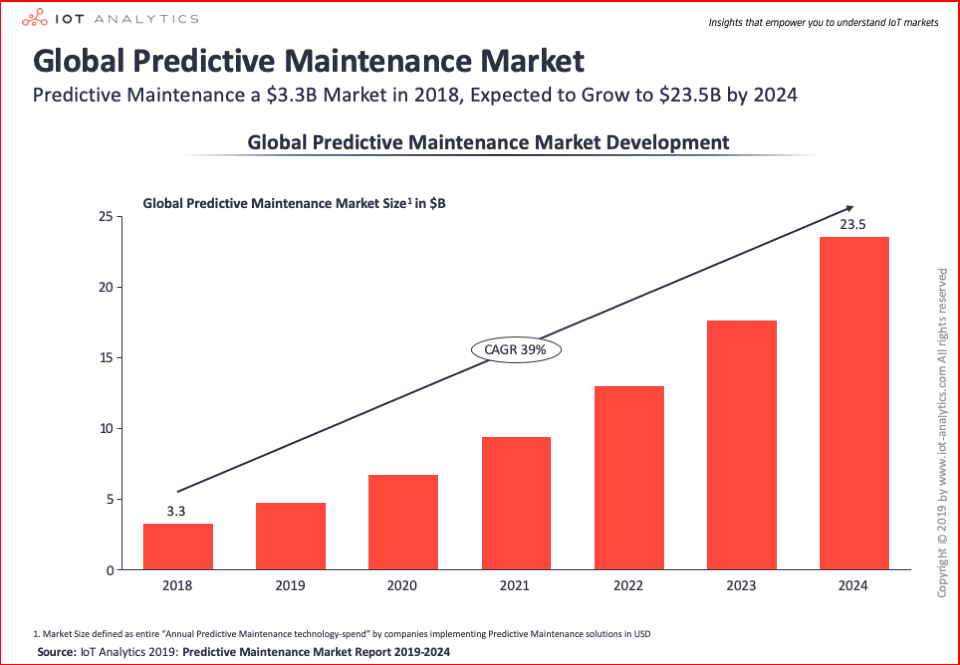Advances in Internet of Things and in Analytics/AI technologies are saving companies billions of dollars on their asset maintenance, according to IoT Analytics’ recent Predictive Maintenance Market Report 2019-2024.
The research (performed in early 2019) shows that the number of vendors particularly focusing on Predictive Maintenance has doubled, compared to a similar analysis conducted in 2017. (Note: IoT Analytics only included companies that specifically talk about their Predictive Maintenance offerings in their corporate communication, on product/solution landing pages and appeared to our analyst team as credible vendors that focus deeply on the Predictive Maintenance topic; the list does not claim to be exhaustive).
180+ Predictive Maintenance companies in 2019
IoT Analytics breaks up the Predictive Maintenance companies market into four main segments for 180+ technology vendors and System Integrators:
- Hardware. Suppliers of specialized hardware for Predictive Maintenance in two areas:
- Condition Monitoring: Companies offering sensing and condition monitoring solutions for the measurement of machine parameters such as vibration or temperature.
- Industrial Automation: Companies offering industrial control systems e.g., PLC/DCS for handling processes and machines and/or the corresponding data historians.
- Connectivity. Companies enabling wired/wireless connectivity through modules, gateways, managed M2M connections, etc.
- Storage & Platform. Companies that offer cloud storage and IoT Application Enablement Platforms that support Predictive Maintenance applications.
- Analytics. Companies offering data engineering, data science services and integration of machine learning.
The breakdown shows that Analytics is the most crowded segment accounting for 35% of the Predictive Maintenance companies, followed by Hardware (28%), Storage & Platform (25%), and Connectivity (6%). Note: Companies offering system integration and other services (6%) across the stack for Predictive Maintenance solutions are also included in the analysis.
A further deep dive into the Analytics segment shows 9 types of Predictive Maintenance analytics vendors across 4 main categories: Basic Analytics, Data Engineering, General Data Science, and Predictive Maintenance Tailored Analytics.
9 Types of Predictive Maintenance Companies focusing on Analytics
Basic analytics
- Data visualization: Software for creation of dashboards, graphs, etc. e.g., Tableau, Sisense.
- Analytics libraries: Statistical and mathematical packages that can be used to build Predictive Maintenance models/software e.g., Tensorflow, Python.
Data engineering
- Big data automation: Service/product for automation of data acquisition/data entry process e.g., Infoworks, Xtracta.
- Data engineering: Service/product for data engineering process e.g., Data Engineers.
General data science
- Statistical analysis: Software for sophisticated statistical analysis e.g., Statsoft, Vitria.
- Data mining: Software for examining large pre-existing databases in order to generate new information e.g., Rapidminer, Knime.
- Machine learning: Software created specifically for ML applications g., Avora, Shogun.
Predictive Maintenance tailored analytics
- Predictive analytics: Service/product that generates predictions based on machine data e.g., Falconry, Senseye.
- Anomaly detection: Service/product that detects anomalies in real time e.g., Splunk, Numentra.
“Specialized Analytics” companies tend to focus on offering one type of analytics for Predictive Maintenance (e.g., Tableau offers data visualization, Statsoft offers statistical analysis) while more “General Analytics” companies offer solutions in more than one analytics category (e.g., SAS offers big data automation and data mining capabilities, Mnubo offers machine learning and predictive analytics solutions). The majority of Predictive Maintenance analytics companies identified are classified as “General Analytics” companies as they offer more than one type of analytics.
In many cases, a combination of more than one analytics type is required for Predictive Maintenance solutions and some full-scale Predictive Maintenance solutions may require many or all 9 of the analytics types mentioned here. For most of the analytics companies identified, Predictive Maintenance is just one of many use cases that they provide solutions for e.g., Cloudera also offers a data warehouse and data hub cloud service that enables migration of on-premises data and workloads to the cloud. Furthermore, many Predictive Maintenance analytics companies develop solutions that integrate easily with cloud and IoT platforms e.g., IBM’s Maximo Predictive Maintenance Insights solution integrates into IBM’s cloud offering (IBM Cloud) and IoT offering (IBM Watson) for statistical analysis, predictive modeling, data mining, text analytics, and machine learning on IoT data.
Note: In a similar article in 2017, IoT Analytics ranked Predictive Maintenance companies based on how visibly specific companies presented themselves regarding the Predictive Maintenance topic. However, as a correlation between the ranking and the marketing budget is likely, this ranking may not have been fair to all vendors and was not repeated for the 2019 analysis.
More information and further reading
Interested in learning more about the Predictive Maintenance market?
The details discussed in this article are explored in much further depth in the 136-page Predictive Maintenance Report 2019-2024.
The report takes a deeper look at the Predictive Maintenance companies and the market, including application areas, technology stack, market sizing and outlook, business models and case studies, vendor landscape, drivers, challenges and trends.
IoT Analytics’ estimates the global Predictive Maintenance market reached $3.3B in 2018 and is expected to grow at a CAGR of 39% to become a $23.5B market by 2024. The study, published in June 2019, also includes a PdM project database (110+ case studies), vendor list (180+ vendors) and market model data (11 tables) in Excel format.
A sample of the report and databases can be downloaded here.
Are you interested in continued IoT coverage and updates? Subscribe to our newsletter and follow us on LinkedIn and Twitter to stay up-to-date on the latest trends shaping the IoT markets. For complete enterprise IoT coverage with access to all of IoT Analytics’ paid content & reports including dedicated analyst time check out Enterprise subscription.





